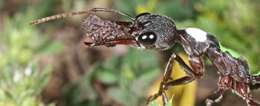Photo by Ajay Narendra.
(PhysOrg.com) -- Researchers studying the eyes of different Australian bull ants have found the first evidence of adaptation of visual structures within a single species to distinct light intensities.
The research, led by Dr. Ajay Narendra of the Division of Evolution, Ecology and Genetics at The Australian National University, found that the eye structure of the bull ants genus Myrmecia changed according to their role in the colony. Ants which were required to work at night and walk were equipped with night vision, while ants whose role required day work or had to fly had a different eye structure.
“Our research shows that the time of day insects are active and the task they carry out influences eye design,” said Dr. Narendra.
“We discovered that in certain species worker activity times and flight times of winged forms do not match. In all cases, individuals active at night were equipped with night-vision equipment: more and larger facets and wider rhabdoms (photosensitive structure in the eyes of most arthropods), compared to the day-active individuals.”
Dr. Narendra said the ants’ caste system lent itself to studying differences.
“To identify if tasks carried out by individuals influences eye design, we took advantage of the unique caste system of ants. In ants, workers are sterile females and strictly pedestrian. Each colony also produces winged females that fly for a brief period and then stay in the dark confines of the nest. The colony also produces winged males that lead a life on the wing and have a very short lifespan. Those winged males, in all cases, have more but smaller facets in each eye.
“Insects are active in the day, at twilight or even at night. The striking change that occurs as one moves from day to night is the dramatic decrease in light intensities. Light levels at night are up to a million times dimmer than day light intensities. They restrict activity to certain times of the day to avoid predators and to look for suitable food resources.
“While our work shows stunning differences in eye design tuned to ambient light levels, the improvement in optical sensitivity is modest considering the dim light intensities. Insects might further require temporal or spatial integration of signals to improve signal-noise ratio at dim light. We aim to address this in our future work.”
More information: The researchers' paper is published in the Proceedings of the Royal Society B: Biological Sciences today.
Provided by Australian National University





















